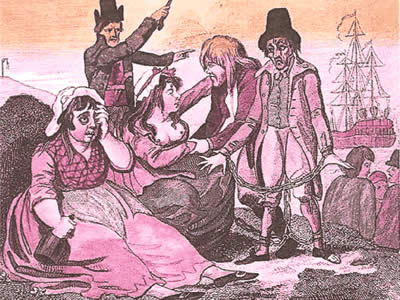Clan Dalton Gathering, Birr, Co Offaly - August 2008
by Michael Neale Dalton
There is no doubt that the weekend in Birr was a resounding
success. For those who attended, I know that each of us will have memories
of the event that we will treasure for a long time. For those of you unable
to be there, we hope that the diary below and the photographs (www.daltongensoc.com/gallery/birr2008)
on this website, will capture a little of the spirit of the occasion and
convey it to you.
I just want to take this opportunity to thank everyone
who helped us to put the weekend programme together and ensure that everything
ran smoothly. Particular thanks go to Ciaran Dalton who, with his wife
Collette, ensured that we all participated in a memorable Irish experience;
and to Jo Duignan and all the staff at Dooly’s Hotel who looked
after us so well; also to Des Connole and his team at The Thatch who made
Sunday evening so special.
Apart from the social aspects of the weekend, the gathering
provided a serious opportunity to further our knowledge of Irish Dalton
family history. The Saturday morning conference enabled delegates to share
the many strands of Irish Dalton ancestry and, of course, this continued
informally throughout the weekend. Many delegates extended their stays
in Ireland before and after the weekend and visited locations associated
with their particular lines. I am sure we will be hearing more from each
of them here on this page or in “Daltons in History”
or in the pages of the DGS Journal, as they piece together their individual
Dalton family jigsaw puzzles.
CHAIRMAN'S DIARY
Wednesday 30th July 2008
Left Reigate after lunch and drove to Parkgate on the Wirral
where I stayed overnight with Dick and Jenny Stock.
Thursday 31st July 2008
Up in good time for a planned 8.30am departure for Holyhead
where I arrived at 10.15am in more than ample time for the noon ferry crossing
to Dublin. The weather was dull and the sea was described as moderate. In the
event the crossing was very comfortable with a near empty club lounge and excellent
complimentary refreshments. Disembarked at Dublin soon after 2.00pm and drove
north through the new tunnel out to the airport and found a quiet spot to relax
before picking up Kate and Maureen who were scheduled to land at 4.25pm. A text
message from Kate informed me that their Ryanair flight was delayed by an hour
and a half, so I settled down to some final preparation work for the Gathering.
Drove over to the airport and parked the car around 6.00pm – met Kate
and Maureen and, after telephoning Dooly’s and The Maltings to advise
of later arrivals, we set off for Birr around 7.00pm. After a good run we arrived
in Birr well before 9.00pm and found Mel & Dairne, John & Sheila, Pam
& Dave, Howard and Velma Boudreau in the bar. John & Sheila were very
impressed with the Walcot B&B where they had been moved to for the first
night (four poster bed and all); Howard was less impressed with his enforced
move to the Spinners B&B (Dooly’s had failed to book him in for Thursday
night). Kate, Maureen and I had a late dinner in the bar and took an early night
after what had been a long day of travelling for us all.
Friday 1st August 2008
After breakfast in the coffee shop, we set up the Cumberland
Suite for our Gathering. With the help of the other committee members,
plus Kate and Sheila, we soon had everything ready – projector working,
displays arranged, charity raffle prizes set out, programmes and badges
ready for the delegates. Mel and I sorted out the intricacies of the Gathering
finances and worked out the balances in euros owed by each delegate. Before
12 noon delegates started to arrive – our 2008 Birr Gathering had
begun. It was a pleasure to greet our many new delegates, attending their
first ever Clan Dalton Gathering and, of course, to renew old acquaintances.
By 2.30pm there were well over 30 assembled in the group to
walk over to Birr Castle for a tour of the grounds and the Scientific Heritage
Centre. One of the highlights was a talk about the wonderful old telescope that
has recently been restored and shortly will be in use again to view the night
sky. Following the talk, delegates were free to wander around the grounds at
leisure and enjoy the impressive parkland with its lake, its formal gardens,
its magnificent specimen trees and its beautiful views. We were also blessed
with warm sunshine – an added bonus.
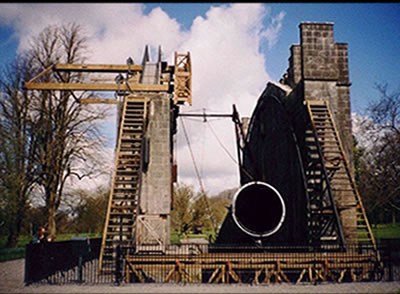
Forward Facing View of Birr Telescope as it is Today
At 6.00pm we opened the registration desk again and welcomed
the later arrivals. Then at 7.00pm there was a wine and cheese reception in
the Cumberland Suite, which allowed all of us to mingle, meet old faces and
exchange news, and get to know our new delegates. Howard organised the tables
for dinner in the Emmett Restaurant and ensured a steady flow into the dining
room, which enabled the hotel staff to manage our large party without a bottleneck.
Howard did this impeccably, but the Dooly’s staff appeared rather overwhelmed
and some of us still suffered a little delay! Following dinner there was time
for mingling before retiring to bed.
Saturday 2nd August 2008
Delegates were asked to assemble at 9.45am for the Saturday
morning conference, scheduled to commence at 10.00am. Some were there
well before then to take a closer look at the displays and most had arrived
in time for our prompt start at 10.00am when I opened the first session
and welcomed all present and, in particular, those attending their first
ever DGS Gathering, of whom there were no less than 18. Delegates had
travelled from all over the world – Australia, New Zealand, the
United States including Alaska, Canada including Newfoundland, together
with Ireland and the UK, a total of 42 and a truly international gathering.
After running through the programme for the weekend, we moved into an
interactive session introducing the Dalton Genealogical Society and our
Irish Dalton ancestors. I reported briefly on the Society’s AGM
held at Camberley, Surrey on Saturday 7th June and then Geoffrey spoke
about the superb tour of the medal collection at the Headquarters of the
Royal Logistics Corps, which of course included the James Langley Dalton
VC. Our editors, John and Dairne followed with updates on the DGS Journal
and on the monthly web newsletter, “Daltons in History”.
I gave an update on the Dalton International DNA Project – it was
particularly good to see so many members of identified genetic families
amongst our delegates, many of them meeting their fellow genetic cousins
for the very first time. Then Maureen and Helen Smith informed us all
about the plans for the next DGS Annual Gathering, taking place in Orange,
New South Wales, Australia in March 2009. This concluded the first session
and everyone took a well-earned and welcome coffee break.
Following coffee, we moved on to the talk given by Ciaran
on Richard D’Alton Williams. Ciaran gave a witty and informative
account of this interesting man, who he described as one of our more famous
forebears. Born in Dublin in 1822, Richard D’Alton Williams spent
his early life at Grennanstown in Tipperary. He studied medicine but then
achieved recognition as a leading poet, writing in the “Nation”
newspaper, a forum for new political thinking on Ireland in the mid 19th
Century. Ciaran’s talk, illustrated with excellent
slides, gave us an insight into the life and thinking of Richard and
concluded with details of his later life in America, where he died of
consumption in Louisiana in 1862, just short of 40 years old.
The remaining time before lunch was used for short presentations
by delegates about their Irish Dalton ancestry. Contributions were made by Karen
Preston (coordinator of genetic family D), Wendy Fleming (coordinator of genetic
family B), Tom Daulton from genetic family X, Mike Dalton of Oregon with roots
in Co Kerry, Margaret Engler (Co Waterford and Co Wexford), Mel Irwin (Co Tipperary),
Velma Boudreau (Co Waterford and Co Wexford), Kathleen Casey (Co Galway), Cathy
& Regina Negrycz (Co Cork), Ana O’Connell (Co Westmeath) and Pat Robinson
(Co Tipperary). Their individual accounts about their ancestors and their researches
informed us all and, along the way, were very entertaining as well. Just after
1.00pm, I had to draw the proceedings to a close and we adjourned for a buffet
lunch set up for us in the adjacent room.
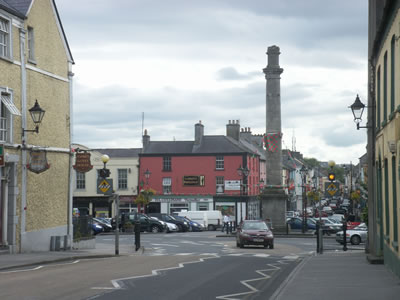
Emmett Square and the missing Duke of Cumberland
In the afternoon, we were joined by Margaret Hogan, a well
known local historian, and member of the Birr Historical Society, who had agreed
to take us on a guided walk around Birr. Before setting off, she gave us a short
illustrated presentation to provide some historical background to our walk.
We then commenced the walk in Emmet Square and learnt about the Duke of Cumberland,
whose statue used to be at the top of the column in the square. From there we
went along John’s Mall to see many fine Georgian buildings including John’s
Hall. We walked on to the Birr Library, now housed in what was the Convent for
the Sisters of Mercy, a very fine Gothic building designed by Pugin. Inside
there were many interesting displays, including a facsimile copy of the Gospel
Book of Macregol of Birr, a very fine 9th Century illuminated document, which
is an important relic of the early Christian monastery at Birr. The original
is in the Bodleian Library in Oxford. Adjacent to the library is St Brendan’s
Roman Catholic Church, another fine Gothic building opened in 1826, which includes
some beautiful stained glass windows. Our walk continued along the walk by the
side of the Camcor River to Market Square at the bottom of Main Street, where
there is a somewhat controversial monument to the Manchester Martyrs, three
Irish nationalists executed in England in 1867. Margaret’s knowledge of
Birr and her lively commentary enabled us to see much that would otherwise have
been passed unnoticed and we are most grateful to her.
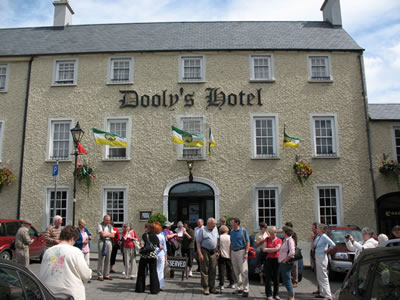
Dooly's Hotel
There was a little time for delegates to relax before the DGS
Annual Dinner and some of us walked on and explored other parts of what is a
very interesting old town. At 7.00pm we assembled for the pre-dinner drinks
reception and then 44 of us took our seats at five round tables for what we
all agreed was a superb dinner prepared by the Dooly’s Hotel chef. Margaret
Hogan joined us as a guest, as did Dave and Ann Hegarty, friends of Ciaran.
Dave had been invited in order to entertain us after the meal by playing the
Uillean pipes, an Irish version of the Scottish bagpipes. We much enjoyed the
beautiful and subtle sounds of these Irish pipes and the programme of Irish
folk music that he played for us. Following this musical interlude, we held
our annual charity raffle, ably organised by Kate who had sold 236 euros worth
of tickets. The chosen charity was the British Heart Foundation and a donation
of £200 will be sent in memory of the late Dr Lucy Slater, for many years
DGS committee member and Executive Secretary.
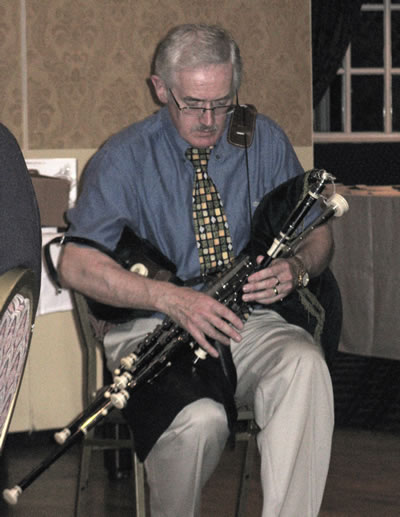
Dave Hegarty with his Uillean Pipes
To conclude the evening, Ciaran and Collette invited us to
join in some Irish country dancing. They provided the music and the directions,
and amongst much hilarity, DGS members were to be seen taking to the floor,
and enjoying each other’s company in this way. Some displayed great talent
on the dance floor and it was good to add this new dimension to our Gathering
- another milestone for the Society!
Sunday 3rd August 2008
Sunday morning brought more fair weather and, following breakfast,
we set off for a visit to Clonmacnoise. Pam and John had ensured that all delegates
had seats in cars for the 30 minute drive and we met at the site at 10.30am.
Clonmacnoise lies on the banks of the River Shannon, a few miles south of Athlone.
It is an important ecclesiastical site founded in the 6th Century by St Ciaran.
Our tour started in the Visitor’s Centre, which includes superb displays
and some of the original high crosses, now housed inside to preserve them. The
excellent audio-visual presentation gave us an insight into the history of the
site and then we went outside to be shown round by Sean, one of the site guides.
The amazing collection of churches, towers, crosses and gravestones is amongst
the most extensive of their kind in Ireland. We know that Daltons are buried
there, but unfortunately we were not able to locate the graves – only
limited work has been done to record the inscriptions, but it is hoped to extend
this and make it available in years to come. Adjacent to the site is a new churchyard
where we found and recorded the inscriptions on six Dalton gravestones. A number
of us also walked to the Nun’s Church, a fine Romanesque nave-and-chancel
structure with a finely carved doorway and chancel arch. Clonmacnoise proved
a most interesting place for the DGS to visit and it is perhaps fitting that
our Irish Secretary shares his name with the founder. St Ciaran was well known
for performing minor miracles, an attribute that perhaps he has passed on to
his namesake!
From Clonmacnoise we drove to the Shamrock Lodge Hotel in Athlone
where an enjoyable light buffet lunch had been arranged in a private room. Suitably
refreshed, delegates embarked on an afternoon that provided a choice of activities.
Some stayed in Athlone and looked round the very fine castle. Others went to
Shannonbridge for a trip on the Bog Railway. This guided tour across the Offaly
peat bogs provided an insight into the historical importance of peat to the
Irish economy – indeed peat is still used today as fuel for the generation
of electricity. A third group found a local distillery to visit and sample the
Irish whiskey.
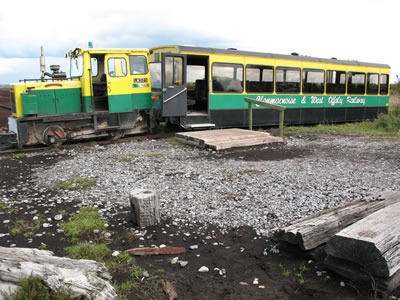
The Bog Railway
Everyone returned safely to Birr in the late afternoon to ready
themselves for the traditional Irish evening arranged at The Thatch Restaurant
at Crinkill, a small village just a couple of miles outside Birr. Des Connole,
the owner, welcomed us and showed us to the private room reserved for our party.
A magnificent three-course dinner was served and, after the obligatory group
photograph and some rearrangement of the room, it was over to Ciaran and Collette
again to lead us in an evening of traditional Irish music, interspersed with
many contributions from delegates – songs, recitations, jokes (clean ones!)
and reminiscences about the weekend. It was truly an evening to remember for
its camaraderie and the demonstration of such diverse talents displayed by us
Daltons. What a talented group we are! All too soon the evening drew to a close
and we returned to Dooly’s where many of us enjoyed a nightcap before
retiring.
Monday 4th August 2008
And so to the conclusion of the weekend and bidding our farewells.
From the start of breakfast through until late morning, I found myself
busy saying goodbye, but before the final farewell, there was many a further
conversation, and these demonstrate the true fellowship that has become
a hallmark of our Gatherings.
All agreed that it had been a superb Gathering, bringing together
a wide and international group of people, sharing the common bond of Dalton
ancestry. The mixture of family history, and the opportunity to enjoy and participate
in some unique and truly Irish experiences, provided something for each of us
to remember.
Kate and I finally packed up our car and departed from Dooly’s
around midday. We set off for a week of exploring in Co Clare, Co Galway and
Co Mayo with many happy memories of Birr fresh in our minds. |
